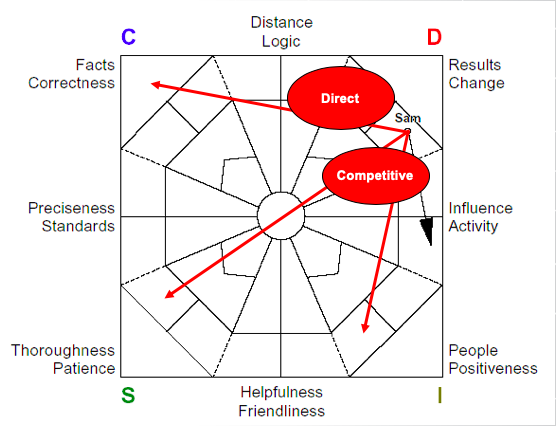People who feel they've achieved success often face a challenge called the Success Trap.
While you're delivering a sales, leadership or communication workshop, some of your clients may be thinking, 'I'm successful - why should I change?' It can create a bigger challenge because they feel their success is attributed to their past and current behavior; therefore, it will continue if they just keep on doing what they're doing. But, what happens if what they're doing doesn't work?
The Success Trap

You've probably been to a Blockbuster Video, Toys R Us, or Sears, right? These stores were very successful companies - until they weren't. While a Success Trap commonly applies to companies, it can also apply to individuals - including your clients.
We are all capable of success, regardless of our DISC styles. However, if we don’t adjust our styles appropriately, then we will get stuck and end up in trouble. Ironically, it can be our success that pushes us into this trap. Success is hard won; we are even less motivated to change when we feel we are achieving our goals. Change is a pain and can take a lot of energy. When your client feels successful it can further impede their motivation to change.
Are you successful because of your behaviors or in spite of them?

Marshall Goldsmith, a well-known executive coach, came up with the Superstition Trap. It simply states that the more you achieve, the more you associate it with repeating behaviors. Your clients need to identify if they are achieving success because of their behaviors or in spite of them? Don't confuse “because of” and “in spite of” behaviors.
Superstition occurs when there is a disconnect between correlation and causality. Your success may create assumptions, “I behave this way, and I achieve results. Therefore, I must achieve results because I behave this way.” Successful people do a lot of things right, but some people are successful in spite of some behaviors. At some point, their behaviors will not create success.
Therefore, how do we help our clients become more aware of the behaviors that get in their way? They may not want to make changes that could alter their current success.
How your Comfort Zone helps you avoid the Success Trap
 How can you help your clients be aware of the Success Trap? DISC helps your client to identify their Comfort Zone. The Comfort Zone identifies your most comfortable behavioral styles on the DISC Model. You prefer these behaviors because they don't drain your energy and they feel the most natural.
How can you help your clients be aware of the Success Trap? DISC helps your client to identify their Comfort Zone. The Comfort Zone identifies your most comfortable behavioral styles on the DISC Model. You prefer these behaviors because they don't drain your energy and they feel the most natural.
However, there are situations where we need to leave our Comfort Zone in order to be successful. It will take adjustment, energy, and sometimes discomfort. You can help your clients better prepare for these situations by recognizing what is within and outside their Comfort Zone. Ultimately, practicing these adjustments throughout the day leads us to be more successful.
Confident Self-Awareness is the Key
Where do you start? The most successful people we know have a keen sense of how they behave. They do not all share the same DISC style, but they all share self-awareness and confidence. Their behaviors are not forced; they own their strengths and don't overuse them. In addition, they are aware of, even comfortable with, their areas of development and how to adjust them.
Your clients react positively to learning about their strengths in the DISC Assessment, but then they tend to focus on their weaknesses. Instead, we need to help them recognize it might be the overuse of their style that gets them into trouble.
Overcoming the “Too-Effect”
 Have your clients look at the Strengths section in their DISC report. Ask them to consider what happens when they feel pressured, frustrated or fatigued. Strong emotions are the enemy of behavioral change. Different styles perceive stress differently, but when we feel strong emotions, we just don't have the capacity or energy to make adjustments. Strengths should be used, but we can overly rely on them to the point of overusing them where they become a liability. Self-awareness helps us understand how we tend do things so we can then be more proactive and focus on more appropriate behaviors.
Have your clients look at the Strengths section in their DISC report. Ask them to consider what happens when they feel pressured, frustrated or fatigued. Strong emotions are the enemy of behavioral change. Different styles perceive stress differently, but when we feel strong emotions, we just don't have the capacity or energy to make adjustments. Strengths should be used, but we can overly rely on them to the point of overusing them where they become a liability. Self-awareness helps us understand how we tend do things so we can then be more proactive and focus on more appropriate behaviors.
For example, a D-style feels comfortable being direct and competitive. These natural strengths can help the D-style achieve success, but when overused, they can start to be too direct and too competitive. D-styles move quicker than most people. That’s good, but learning to slow down the pace, to accommodate others, can actually help them get to their goals faster. They can practice more humility and being more patient, and avoid being abrasive, too blunt, and insensitive to others.
I-styles can practice listening more, following through, and discipline. S-styles can practice building self-confidence and being more decisive. They can also practice 'healthy selfishness'; the team benefits when they focus on their personal goals. C-styles can focus on being less critical and understanding that “good” is enough and “perfect” is not always the best or realistic.
Breaking out of the Success Trap
 Our belief in our success doesn’t mean we don’t need to change. It can make it harder to want to change. Your clients can avoid the Success Trap by building self-awareness and knowing when to move outside their Comfort Zones. It requires energy and may feel uncomfortable, but practice makes it easier over time.
Our belief in our success doesn’t mean we don’t need to change. It can make it harder to want to change. Your clients can avoid the Success Trap by building self-awareness and knowing when to move outside their Comfort Zones. It requires energy and may feel uncomfortable, but practice makes it easier over time.
Changes are not always required and may not apply to all roles, but should be done where it will achieve results. Remember, the most successful people are self-aware and build change into their daily behaviors.
We've said it before, and we'll say it again, 'success is not a destination, but a journey.'
